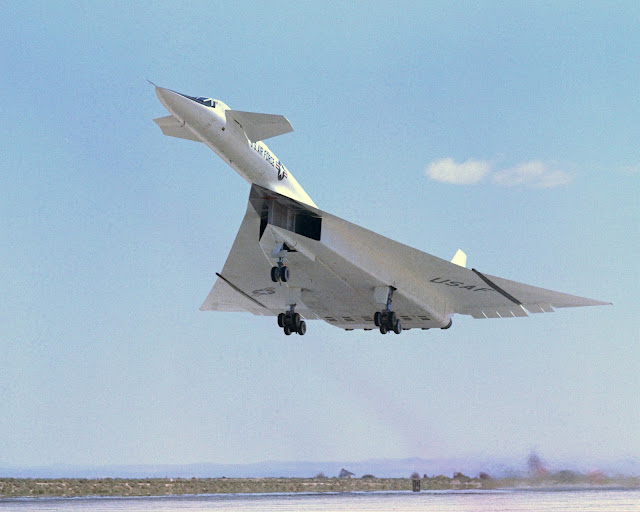Introduction
Overview of the 1950s
The only prototype of an airplane built in the 1950s as a high-altitude, nuclear strike bomber that could fly at Mach 3 is on display at the National Museum of the U.S. Air Force at Wright-Patterson Air Force Base (AFB) outside of Dayton, Ohio. Wright-Patterson Air Force Base (AFB), which is part of the United States Air Force, houses the museum (at three times the speed of sound).
Introduction to the only prototype of an airplane built in the 1950s
The fact that the futuristic-looking XB-70 "Valkyrie" soared to the sky
only sixty years after the Wright Brothers completed the maiden flight
is one of the elements that makes this achievement particularly amazing.
It showed how far people's ideas had come about airplanes in the
first half of the 20th century.
Background
History of the airplane
The North American Aviation (NAA) Los Angeles Division built the XB-70A, an experimental high-speed delta-wing aircraft for the United States Air Force. It was built to fly at Mach 3, or three times the speed of sound, at heights of more than 70,000 feet (21,000 kilometers). The goal of the program was to make a high-altitude nuclear strike bomber that could outrun any interceptor that was sent in its way. The Strategic Air Command wanted the B-70 to be a strategic bomber that could fly fast, go deep into enemy territory, and carry nuclear bombs.
Development of the prototype
The experimental XB-70 and the British-French turbojet-powered Concorde supersonic passenger airline, which flew from 1976 to 2003, are built similarly. Both aircraft feature delta wing profiles, and there are design commonalities throughout the plane. On the other hand, it is quite likely that the B-70 design was created long before the concept of a high-speed passenger aircraft was considered.
Design
Specifications
According to the designs that were established when it was first built, the XB-70A, which was powered by six General Electric YJ93s with 30,000 pounds of thrust apiece and an afterburner, was expected to reach a top speed of Mach 3.1 (2,056 miles per hour, or 3,309 kilometers per hour).
It could reach a maximum speed of Mach 3.00 at its service ceiling of 75,550 feet (23,012 meters), but only Mach 1.90 at an altitude of 35,000 feet (10,668 meters). This translates to 1,254 miles per hour or 2,018 kilometers per hour (1,982 miles per hour or 3,190 kilometers per hour). The B-70 was meant to have a combat range of 3,419 miles (5,502 kilometers) and a maximum range of 4,290 miles (6,560 kilometers) (6,904 kilometers).
Features
The military planners thought that the bomber could fly so high and fast that it would be hard for any enemy, especially the Soviet Union, to stop it.
The XB-70 Valkyrie, on the other hand, was unable to outpace developments in missile technology, which was the one thing it couldn't outrun.
Impact
Impact on the aviation industry
By the early 1960s, surface-to-air missile (SAM) technology had advanced significantly. This made it difficult for even quick, high-altitude bombers to survive. During this time, cheaper nuclear-tipped ICBMs (intercontinental ballistic missiles) were being deployed. Because of this, work on the expensive B-70 bomber stopped in 1961, before any Valkyries were finished or took their first flight.
Each aircraft was reportedly expected to cost over $24.5 million, which equates to nearly $240 million in today's money. However, this proved to be an unaffordable sum for an aircraft of this type.
Relevance today
The Valkyrie could have ended there, but the US Air Force continued with the program and purchased two XB-70As to test the aerodynamics, propulsion, and other elements of big supersonic aircraft. At the time, NASA and the Air Force were collaborating on SST research, and the XB-70 Valkyrie proved to be a suitable testbed for this work. It was the same size as the SST designs, and it was built with similar materials, such as a honeycomb of brazed stainless steel and titanium.
Conclusion
Summary of the airplane and its impact
When the first XB-70A flew in from Air Force Plant 42 in Palmdale, California, to Edwards Air Force Base in September 1964, Chief Test Pilot Alvin S. White and Colonel Joseph F. Cotton, both of the United States Air Force, were at the controls. The plane is now on display at the United States Air Force National Museum.
The plane was able to fly at Mach 3 in October 1965, and the prototype kept flying and giving important test data to the research program until February 4, 1969, when it made its last research flight before being put away. It was handed over to the museum in the latter half of that year.
Call to action
A second Valkyrie took to the skies for the first time in July 1965. However, in June 1966, it was destroyed in an air accident that killed the co-pilot, Major Carl Cross. The building of a third Valkyrie was never finished.





